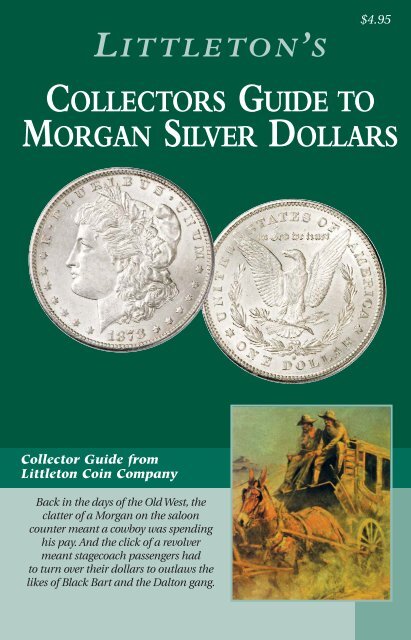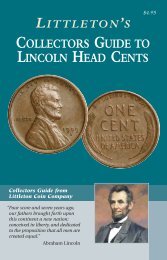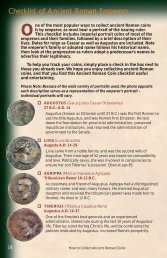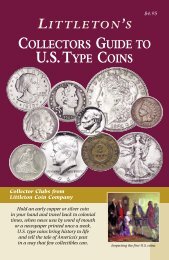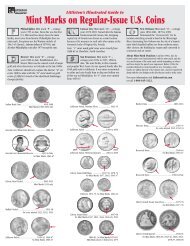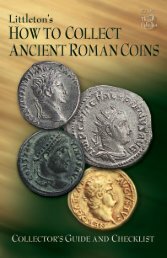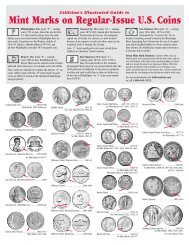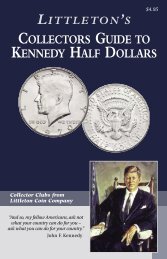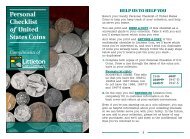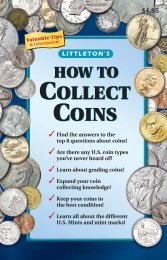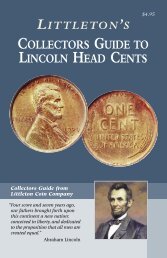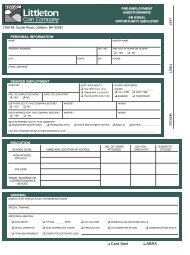Collectors Guide to Morgan Silver Dollars - Littleton Coin Company
Collectors Guide to Morgan Silver Dollars - Littleton Coin Company
Collectors Guide to Morgan Silver Dollars - Littleton Coin Company
You also want an ePaper? Increase the reach of your titles
YUMPU automatically turns print PDFs into web optimized ePapers that Google loves.
LITTLETON’S$4.95COLLECTORS GUIDE TOMORGAN SILVER DOLLARSCollec<strong>to</strong>r <strong>Guide</strong> fromLittle<strong>to</strong>n <strong>Coin</strong> <strong>Company</strong>Back in the days of the Old West, theclatter of a <strong>Morgan</strong> on the salooncounter meant a cowboy was spendinghis pay. And the click of a revolvermeant stagecoach passengers had<strong>to</strong> turn over their dollars <strong>to</strong> outlaws thelikes of Black Bart and the Dal<strong>to</strong>n gang.
Dear Collec<strong>to</strong>r,<strong>Silver</strong> and <strong>Morgan</strong> <strong>Dollars</strong>! Words that workmagic on collec<strong>to</strong>rs and anyone who hasever held these big shiny silver coins intheir hands. And <strong>Morgan</strong> silver dollars tellthe s<strong>to</strong>ry of mountain men, pioneers andprospec<strong>to</strong>rs who opened up the West, andthe families who settled the open prairies.Nicknamed “King of America’s <strong>Coin</strong>s”These big, heavy 90% silver coins werestruck using ore gleaned from rich westernmines – like the Coms<strong>to</strong>ck Lode, whichDavid M. Sundman,yielded $36 million annually at its peak!LCC PresidentLarge, handsome, and weighing over 3/4 ofan ounce, it’s easy <strong>to</strong> see why these his<strong>to</strong>ricsilver dollars have earned the nickname “King of America’s<strong>Coin</strong>s”! The magnificent <strong>Morgan</strong> dollar was struck for 27 years,from 1878 through 1904, and one final time in 1921.As we move further in<strong>to</strong> the 21st century, more peoplecollect <strong>Morgan</strong> silver dollars than at any other time. Yet, unlikethe beginning of the 20th century, there are no more largehoards. These huge caches were dispersed decades ago, andmillions of <strong>Morgan</strong>s disappeared in<strong>to</strong> private collections wherethey could remain for years. That makes locating <strong>Morgan</strong>s witheye appeal more difficult <strong>to</strong>day.Have a plan for your collectionIt’s always good <strong>to</strong> have a plan and focus for what you want <strong>to</strong>collect. Although there is a variety of ways, building a completedate and mint mark collection is considered by many <strong>to</strong> be theultimate achievement. The anticipation of waiting <strong>to</strong> fill thenext space in your album becomes proud satisfaction when youlocate that coin.Of course, one of the greatest thrills of collecting is huntingfor coins, like the first-year 1878 <strong>Morgan</strong>s in Uncirculatedcondition. Although there are rare dates like the 1895 or1893-S, there are also the popular, <strong>to</strong>ugher semi-key dates likethe 1879-S, 1886-S and 1893-O, <strong>to</strong> mention a few.Whatever your level of interest or experience, I hope you’llfind this collec<strong>to</strong>rs club booklet on <strong>Morgan</strong> dollars a useful,interesting, and educational guide <strong>to</strong> the series.Sincerely,David M. SundmanPresident2
Collecting is a way <strong>to</strong> make time stand still, or at least <strong>to</strong> bring the pastalong with us. If nothing were saved, we would have no knowledge of thepast except for what we read. And bygone days would slip in<strong>to</strong> obscurity.But with collectibles, the past comes alive. <strong>Coin</strong>s are especiallyfascinating, for they were (and are) the means of daily commercialexchange. When you hold a 50 or 200 or 2000-year-old coin in your hand,you can’t help but imagine who might have used it or where that coin mighthave been in its lifetime!Table of ContentsThe Legend of the Coms<strong>to</strong>ck Lode& Birth of the <strong>Morgan</strong> <strong>Dollars</strong> ..................41878 – The First Year of Issue ........................6His<strong>to</strong>ry of the Philadelphia andNew Orleans Mints ..................................8The Only Year Denver Minted <strong>Morgan</strong>s ......12The San Francisco Mint................................14The Carson City Mint ..................................16The “<strong>Silver</strong> Kings” Get Richer ......................181880s – Innovations and Hardships ............20The <strong>Morgan</strong> <strong>Silver</strong> Dollar Hoards ................22The His<strong>to</strong>ry of Little<strong>to</strong>n <strong>Coin</strong> <strong>Company</strong> ......25What Can Little<strong>to</strong>n <strong>Coin</strong> Do for Me? ..........26Caring for Your <strong>Coin</strong>s ..................................273
The Legend of theComs<strong>to</strong>ck Lode and Birthof the <strong>Morgan</strong> DollarThe romance of the Coms<strong>to</strong>ck will never die. The s<strong>to</strong>ry is an epic. It was the laststand of the California pioneers where they rose <strong>to</strong> the height of their brilliantand adventurous careers; and a robust and optimistic people throughoutNevada, many of whom were also pioneers, shared in making unforgettablehis<strong>to</strong>ry. Life was never the same for many of them in the after years, but nothingcould take from them their golden memories of the Coms<strong>to</strong>ck Lode.-- The His<strong>to</strong>ry of the Coms<strong>to</strong>ck LodeIn 1859, Patrick McLaughlin and Peter O’Rileywere prospecting in Six Mile Canyon nearCarson City, soon <strong>to</strong> be the capital of theNevada terri<strong>to</strong>ry. Digging a ditch <strong>to</strong> collectwater, they found a rich black soil thatyielded a layer of glittering ore. McLaughlinand O’Riley were experienced miners andinstantly recognized gold. They eagerly began<strong>to</strong> wash away the heavy black soil.In a few short hours, Henry Coms<strong>to</strong>ckcame riding by on a borrowed pony. He wasa colorful character and had a gift for gab.Without a shred of evidence, Coms<strong>to</strong>ckconvinced McLaughlin and O’Riley that hehad a claim on the very spot in which theyhad found gold. After a long argument, thetwo agreed <strong>to</strong> take Coms<strong>to</strong>ck in as a partner<strong>to</strong> avoid any trouble.Coms<strong>to</strong>ck talked so much of “his” minethat soon, hundreds of prospec<strong>to</strong>rs wereswarming over Six Mile Canyon, washingaway the black soil from the gold in the Coms<strong>to</strong>ck Mine.Queen of the <strong>Silver</strong> StrikesJ. F. S<strong>to</strong>ne, a veteran of the California gold rush, was intrigued by theComs<strong>to</strong>ck vein of gold in the Nevada terri<strong>to</strong>ry. Curious about the heavyblack soil being thrown aside by the <strong>to</strong>n, S<strong>to</strong>ne sent a sample <strong>to</strong> beassayed in California.Henry Coms<strong>to</strong>ck’s onlycontribution <strong>to</strong> the discoveryof the Coms<strong>to</strong>ck Lode was hisability <strong>to</strong> argue at length!The soil turned out <strong>to</strong> be incredibly rich in silver, yielding $4,700 a <strong>to</strong>n.So enormous was this claim that over the next two decades, the Coms<strong>to</strong>ckLode produced more than $300 million in precious metals – and that wasin 19th-century dollars! Today, the Coms<strong>to</strong>ck Lode of Nevada is stillknown as the Queen of the <strong>Silver</strong> Strikes.4
What became of the partners?Despite the immense yield of the Coms<strong>to</strong>ckLode, none of the original partners got rich– they all sold out <strong>to</strong>o soon!Patrick McLaughlin sold his share for$3,500 and soon was broke. He died a fewyears later while wandering from place <strong>to</strong>place, working at odd jobs.Henry Coms<strong>to</strong>ck, who consideredhimself a shrewd bargainer, sold his portionof the claim for $11,500. This is a betterprice than McLaughlin received, but ifComs<strong>to</strong>ck had waited until the main silvervein was reached, his interests would havebeen worth $80 million. Coms<strong>to</strong>ckcommitted suicide while prospecting inMontana in 1870.Peter O’Riley held his share until hewas offered $50,000, but he began dealingin mining s<strong>to</strong>cks and lost everything. Underthe influence of “spirits,” O’Riley started <strong>to</strong>dig a tunnel in<strong>to</strong> a nearby peak, believinghe was on the trail of a richer strike thanthe Coms<strong>to</strong>ck. The spirits drove him crazy withAs shafts were dug in<strong>to</strong> thehillside, tracks were laid for themining cars. Although therewere riches <strong>to</strong> be had, miningwas no easy job. The hourswere long, the work dirty,and the conditions harsh.visions of gold and silver caverns. He spent his last days in a California asylum.The Coms<strong>to</strong>ck Lode and other mines caused Nevada’s population <strong>to</strong>grow ten-fold by 1880. <strong>Silver</strong> deposits played a very important role in thestate’s, as well as the nation’s, his<strong>to</strong>ry. Prior <strong>to</strong> its discovery, silver wasused sparingly for coinage, but afterward a flood of silver coins and dollarswas struck. In fact, this abundance of silver and the fabulous Coms<strong>to</strong>ckLode helped give birth <strong>to</strong> the <strong>Morgan</strong> silver dollar!A pho<strong>to</strong> from the Keys<strong>to</strong>neView <strong>Company</strong> of a typicalmining camp from theComs<strong>to</strong>ck Lode era. Manymining camps grew in<strong>to</strong>good-sized <strong>to</strong>wns that werelater deserted when theLode ran dry.5
1878 – The FirstYear of IssueThe <strong>Morgan</strong> silver dollar was first minted in 1878, after a lapse of fiveyears in the production of circulating silver dollars. The coin had a roughstart, which would give the first-year-of-issue <strong>Morgan</strong> dollars an extrameasure of interest and his<strong>to</strong>rical significance.The trouble began five years beforethe first <strong>Morgan</strong>s were minted. TheMint Act of February 1873 ended theproduction of the Liberty Seated silverdollars in favor of Trade and gold dollars.<strong>Silver</strong> dollars made up less than onepercent of circulating silver, so the publicwas not much affected by this change.<strong>Silver</strong> mine owners out West,however, were outraged. They lobbiedand pressured their congressmen. Afterfive years of heated debate, Congressfinally authorized the production of anew silver dollar in 1878.The beautiful new coins became knownamong collec<strong>to</strong>rs as <strong>Morgan</strong> dollars, inhonor of their designer, George T. <strong>Morgan</strong>,English-born assistant engraver at thePhiladelphia Mint.<strong>Morgan</strong> made several studies ofGreek profiles at the PhiladelphiaAcademy of Fine Arts, but was searchingfor an American girl <strong>to</strong> represent Liberty.Thomas Eakins, a renowned landscapepainter and friend of <strong>Morgan</strong>’s, suggestedAnna Willess Williams, a fellow artstudent and schoolteacher.George T. <strong>Morgan</strong>, anEnglish-born engraver for theU.S. Mint, was chosen <strong>to</strong> designthe new silver dollar.Williams was reluctant at first <strong>to</strong> pose for <strong>Morgan</strong>. In those days, “nice”girls did not model for artists! She insisted on strict secrecy, fearing shewould lose her job if the truth were known. Williams sat for <strong>Morgan</strong> fivetimes, and he would later declare she had a nearly perfect profile.Some years later, a newspaper reporter discovered the identity of<strong>Morgan</strong>’s Liberty and over protests, printed the s<strong>to</strong>ry. Williams, as shefeared, lost her teaching position. Fortunately, she found another teachingjob and remained in Philadelphia until her death in 1926, just five yearsafter the last <strong>Morgan</strong> silver dollar was minted.6
The American Eagle on the reverse of the coin wasalso the subject of some controversy. On all previousU.S. coins, eagles had an uneven number of tailfeathers, but <strong>Morgan</strong>’s eagle had eight. There waswidespread agreement that an uneven number oftail feathers was the proper representation of thebird. Under public pressure, the U.S. Mintdecided <strong>to</strong> change the eagle’s tail from eight <strong>to</strong>seven tail feathers.Since Philadelphia was the only mint thathad struck <strong>Morgan</strong>s, mint personnel gathered upall the unused 8-feather dies and simply re-struckthem with the new 7-feather design. As a result,a small number of 1878 <strong>Morgan</strong> dollars havesuperimposed reverse designs and are knownas the 7 over 8 tail feathers variety.Eventually, newly engraved dies withthe 7-feather design were used at thePhiladelphia Mint. As a result, three varietiesof the 1878 <strong>Morgan</strong> silver dollar were produced:8-feather, 7/8-feather and the first 7-feathercoins – all without a mint mark.Later in 1878, the 7-feather coins were struck atAnna Willess Williams, aPhiladelphia schoolteacherand fellow art student,was <strong>Morgan</strong>’s model.This image of her comesfrom an 1892 copy ofLadies Home Journal.both of the western mints – Carson City, Nevada, and San Francisco, California– making five distinct varieties of <strong>Morgan</strong>s during its very first year of issue!Although much controversy and debate surrounded these coins – the<strong>Morgan</strong> silver dollar went on <strong>to</strong> become one of the most popular silvercollec<strong>to</strong>r coins of all time!Shown above are the five first-year varieties of <strong>Morgan</strong> silver dollars. Left <strong>to</strong> right:the 8-feather, the 7 over 8-feather, and the 7-feather, all minted in Philadelphia;the 7-feather CC from Carson City and the 7-feather S from San Francisco.7
A His<strong>to</strong>ry ofThe Philadelphia MintThe his<strong>to</strong>ry of the United States Mint in Philadelphia stretches back <strong>to</strong>the time when George Washing<strong>to</strong>n was president and our nation’s capitalwas Philadelphia. The establishment of the U.S. Mint was provided for inthe Act of April 2, 1792. The first coins struck at the original mint inPhiladelphia were minted, according <strong>to</strong> popular belief, from silverhousehold plates personally delivered by President Washing<strong>to</strong>n himself!The Philadelphia Mint was the first public building erected by authorityof Congress. The Mint remained in Philadelphia after the federal governmentwas relocated <strong>to</strong> Washing<strong>to</strong>n, D.C., although debates continued for thenext 28 years between advocates whobelieved the Mint belonged in thenational capital and opponents whoinsisted it stay in Philadelphia. OnMarch 10, 1828, Congress authorizedthe Mint’s continuation in Philadelphiauntil otherwise provided by law, whichfinally laid the issue <strong>to</strong> rest.A watchdog named Nero waspurchased for $3 and, <strong>to</strong>gether with awatchman, provided security for the firstMint. Construction on a new facility beganin 1829, and the larger Mint operated for70 years. As coinage production increased,the U.S. Mint expanded twice more inthe city of Philadelphia.The “Plain” <strong>Morgan</strong>sThe second Philadelphia Mint beganoperations in 1833 and continued until1901. It was at this Mint that the beautiful<strong>Morgan</strong> silver dollars were first struck andhere that the bulk of the Philadelphia<strong>Morgan</strong>s were minted.Unlike the branches with theirdistinguishing mint marks, thePhiladelphia Mint, because it was thefirst in the nation, struck coins withouta “P” mint mark. These coins are oftenreferred <strong>to</strong> as “plains.”<strong>Morgan</strong>s minted at the mainU.S. Mint in Philadelphia aredistinguished by their lack of amint mark and are sometimesreferred <strong>to</strong> as “plains.” Thesecond Philadelphia Mint(shown above) was a statelybuilding that produced<strong>Morgan</strong> silver dollars from1878 until it closed in 1901.Philadelphia-minted <strong>Morgan</strong>sdated 1902-1921 were struckat the city’s 3rd Mint.“Plain” <strong>Morgan</strong>no mint mark8
The New Orleans MintThe U.S. branch Mint in New Orleans has a his<strong>to</strong>ry as colorful andinteresting as the city itself. Established as the commercial and financialcenter of the entire South, New Orleans wanted some monetaryindependence from the northern banks and the Philadelphia Mint.Heated debates raged between northern and southern sena<strong>to</strong>rs over theneed for a Mint in New Orleans. Southern congressmen s<strong>to</strong>od their groundand a New Orleans branch of the U.S. Mint was authorized in 1835.A stately building occupying an entire block was built next <strong>to</strong> thefamous French Quarter on the banks of the Mississippi River. <strong>Coin</strong>ageoperations began in 1838 and then were suspended for much of 1839when a yellow fever epidemic caused the Mint <strong>to</strong> close.The Mint with Three MastersBy 1860, relations between North and South had become very tense. InJanuary of the next year, Louisiana became the second state <strong>to</strong> secedefrom the Union. Within a week, the state of Louisiana <strong>to</strong>ok over theThe New Orleans Mint was a sprawling, E-shaped building located near thewaterfront. It overlooked the bustling docks that made New Orleans animportant center of commerce by the early 1800s.New Orleans Mint. Some Mint employees, still loyal <strong>to</strong> the Union,destroyed a number of dies.Two months later, the Confederacy <strong>to</strong>ok over the Mint. This was thethird government in ten weeks that had control over Mint operations! TheConfederate Mint struck coins only until May of 1861, then was closed assoldiers raided it for war material.After the Civil War, the New Orleans Mint s<strong>to</strong>od unused until 1876when it opened as an assay office. By 1879, the demands for coinagecaused the U.S. Mint <strong>to</strong> resume regular operations at the branch Mintin New Orleans.9
The New Orleans Mint ceased production in 1909. The building stillstands on the banks of the Mississippi and is <strong>to</strong>day a museum. Thefascinating his<strong>to</strong>ry of the New Orleans Mint is <strong>to</strong>ld through skillfullycrafted exhibits.The “O” <strong>Morgan</strong>sThe <strong>Morgan</strong> silver dollars with the New Orleans “O” mint mark are verypopular with collec<strong>to</strong>rs. <strong>Morgan</strong> production at the New Orleans branchbegan as soon as the Mint resumed coin production in 1879, and <strong>Morgan</strong>swere minted there every year until 1904. That year represents the last timethat <strong>Morgan</strong>s were ever struck at this his<strong>to</strong>ric U.S. Mint. Until the early1960s, when vast quantities were released by the U.S. Treasury, the1904-O was considered one of the prime rarities in the <strong>Morgan</strong> dollarseries. Today this last-year coin is affordable and easy <strong>to</strong> own.New Orleans <strong>Morgan</strong> coinsshown at actual sizeNew Orleans“O” mint mark10
The <strong>Morgan</strong> <strong>Silver</strong> DollarDate: 1878 <strong>to</strong> 1921Designer: George T. <strong>Morgan</strong>Composition: .900 silver, .100 copperWeight: 26.73 gramsDiameter: 38.1 mmEdge: reededMints: PhiladelphiaDenverSan FranciscoNew OrleansCarson City11
The Only YearDenver Minted <strong>Morgan</strong>sOriginally, the Denver Mint operated as an assay office, and neverstruck any <strong>Morgan</strong> silver dollars. In 1921, when silver dollar productionwas resumed, the Mint struck <strong>Morgan</strong>s for the first and last time. A smallnumber of specially engraved <strong>Morgan</strong> silver dollars gave collec<strong>to</strong>rs unusualmemen<strong>to</strong>s of this remarkable occasion at the Denver Mint.In 1862, the government purchased the Clark-Gruber banking facility for$25,000 with the intention of establishing a branch Mint. However, due <strong>to</strong>hostilities with Native American tribes, the Denver facility was never able<strong>to</strong> function as a branch Mint. Instead, it became an assay office, openingin September 1863. Miners brought in their gold, then it was melted andmade in<strong>to</strong> bars. The bars were stamped with the fineness and theinscription “U.S. BRANCH MINT, DENVER.” In 1877, the building haddeteriorated, so funds were appropriated for a new Mint. Although the newMint building was completed in 1904, it was not until l906 that full coinageproduction began.The Pittman Act of 1918 authorized the U.S. government <strong>to</strong> melt downas much as $350 million worth of silver dollars. The resulting bullion wassold <strong>to</strong> Great Britain and shipped <strong>to</strong> India. This British colony’s currencywas <strong>to</strong> be backed by the silver bullion from America.To stabilize the price of silver, the Act also stipulated that thegovernment was <strong>to</strong> buy an equivalent amount of domestic silver <strong>to</strong> replacethose coins that were melted down. The Act proved advantageous in anumber of ways. The British government got the silver it needed <strong>to</strong> backIndia’s currency; the U.S. government received revenue from the millions12Denver “D”mint mark
of silver dollars s<strong>to</strong>red in Treasury vaults; and the American silver industrywas revitalized.<strong>Silver</strong> dollar production was resumed in 1921 at the U.S. Mints. After arespite of 17 years, beautiful <strong>Morgan</strong> silver dollars were <strong>to</strong> be struck for onefinal year! The Denver Mint would strike its first silver dollars.Naturally, this was cause for excitement at the Denver facility.Superintendent Thomas Annear was determined <strong>to</strong> have the event suitablyrecorded for posterity. He arranged for the first 100 <strong>Morgan</strong> silver dollars <strong>to</strong>be engraved with sequential numbers. He would then hand these out assouvenirs of the his<strong>to</strong>ric event. The legend <strong>to</strong> be hand engraved on thecoins read:[1st] DOLLAR RELEASED FROM 1ST 100EVER COINED AT DENVER MINTTHOMAS ANNEAR SUPTHowever, since engraving the 65 letters and digits on<strong>to</strong> each coin would belabor-intensive and time consuming, it is believed that only a smallquantity was engraved. Only 12 engraved Denver <strong>Morgan</strong>s can beaccounted for. The first coin went <strong>to</strong> the Colorado State His<strong>to</strong>rical Societyand remains there <strong>to</strong>day. The second has disappeared without a trace.<strong>Coin</strong>s numbered three through twelve mysteriously ended up in thehands of coin dealer Max Mehl and were auctioned off. A recent sightingof one of these fascinating coins occurred in 1989, when an Illinoiscollec<strong>to</strong>r picked up the 4th engraved coin in change from a bingo game!The <strong>Morgan</strong> silver dollar shown hereis one of twelve known that werespecially engraved at the DenverMint. This was the fourth <strong>Morgan</strong>produced in 1921, and was found by acollec<strong>to</strong>r in change from a 1989 bingogame! The very first engraved <strong>Morgan</strong>went <strong>to</strong> the Colorado State His<strong>to</strong>ricalSociety, and is displayed there <strong>to</strong>day.13
The San Francisco MintEven an Earthquake Couldn’t Shakethe “Granite Lady”The stately San Francisco Mint,pictured here before the earthquakeof 1906, was known as theGranite Lady. The building wasarchitecturally beautiful andstructurally sound. It was one of thevery few buildings that remainedstanding after the quake <strong>to</strong>ok its <strong>to</strong>ll.The California gold rush of 1848caused chaotic conditions as theamount of gold being mined increasedrapidly and in dramatic proportions.Gold was heavy and difficult <strong>to</strong>transport <strong>to</strong> the Philadelphia Mint,and encountered many hazardousmoments on its journey. A number ofprivate mints <strong>to</strong>ok advantage of thesituation and quickly produced coinsthat circulated in great quantities.In order <strong>to</strong> take control, the federalgovernment quickly authorized abranch Mint in San Francisco.A small plant was built, andThe aftermath of the quake, one ofthe worst natural disasters inU.S. his<strong>to</strong>ry, is shown below.operations began in 1854. The tiny Mint was unable <strong>to</strong> meet the demandsof the West and construction was begun on a new, larger Mint in 1872.Two years later, the new branch Mint was ready. Immediately upon itsopening, the Mint was dubbed the Granite Lady, a tribute <strong>to</strong> its size andarchitecture. The massive building was one of the most luxurious Mints inthe world, featuring gold and bronze chandeliers and 14 marble fireplaceson the first and second floors. Its massive structure and architecturalstrength were put <strong>to</strong> the test thirty years later.On April 18, 1906, San Francisco was twisted, broken and burned bythe worst earthquake ever <strong>to</strong> rock the United States. The Granite Ladysurvived the quake due <strong>to</strong> its solid construction, but the real threat was theaftermath – fire!14San Francisco“S” mint mark
California Street, looking west <strong>to</strong>wardNob Hill, is shown at right just before theearthquake hit on April 18, 1906.The trolley tracks on Mission Street,below right, heaved and twisted, anddeep cracks in the pavement appeared.Below is a fire engine that was caughtand crushed by a falling wall.The fire that followed did as muchdamage as the quake itself.Much of San Francisco was engulfed in flames. Because of its thickgranite walls and metal window frames, the Mint was thought <strong>to</strong> beimmune <strong>to</strong> fire. But the incredible heat began <strong>to</strong> shatter the windows andmelt the frames. Underneath the Mint’s vaults was an artesian well, butthe shock of the earthquake had broken its pump. Repairing it enough <strong>to</strong>be operated by hand, some volunteers filled buckets and threw water onthe interior woodwork, which had ignited when the windows blew in. Onthe roof, men with iron bars, picks and shovels <strong>to</strong>re off tar paper andthrew it <strong>to</strong> the ground. The exposed roof beams were then saturated witha fire-retardant liquid.After seven hours, the Mint was blackened and its iron shutters twistedby the heat. But the Granite Lady was safe, still standing in the midst ofthe devastation that was San Francisco. Frank Leach, superintendent ofthe Mint, climbed down from the Mint’s roof where he had been fightingthe fire and noted, “Appears <strong>to</strong> be nothing left out there. It’s all gone.Most of the city seems <strong>to</strong> have burned out.”It was a difficult period for the whole city. Many people had losteverything. Most had no access <strong>to</strong> their savings. Bank safes <strong>to</strong>ok weeks<strong>to</strong> cool enough <strong>to</strong> allow access <strong>to</strong> their contents. Since the Mint was oneof the few buildings <strong>to</strong> survive – and the only financial institution left – itbecame a temporary bank and handled much-needed relief funds forthe city.15
The Carson City Mintand the Great <strong>Silver</strong> Dollar Sale!Kit Carson was a well-known andmuch-admired frontiersman. He rode onmany expeditions exploring the West.Abraham Curry, founder of Carson City, namedhis settlement for this famous explorer.The “CC” mint mark from the branch Mintin Carson City, Nevada is a favorite ofcollec<strong>to</strong>rs. During its years of operation, theCarson City Mint gained a reputation forstriking some of the most finely detailed,high-quality coins in U.S. his<strong>to</strong>ry. The<strong>Morgan</strong> silver dollars that were struck hereare considered <strong>to</strong> be the finest in the series!Carson City, <strong>to</strong>day the capital ofNevada, was founded by a colorfulcharacter named Abraham Curry during the heyday of the Coms<strong>to</strong>ck Lodesilver strike. Curry had purchased a large tract of land along the CarsonRiver, named for the famous frontiersman Kit Carson. Curry proceeded <strong>to</strong>set up a trading post, sold tent and cabin sites <strong>to</strong> prospec<strong>to</strong>rs, and namedthe settlement Carson City.Abe Curry was a shrewd businessmanwho bargained and fought tirelessly <strong>to</strong>improve and develop the city. He finallyconvinced the federal government <strong>to</strong> builda branch Mint in Carson City <strong>to</strong> handleNevada’s large silver supply.Congress authorized $150,000 for theproject in 1866. Abe Curry became thegeneral contrac<strong>to</strong>r for construction. The Mintended up costing three times the originalamount, but it was a fortress.Carson City was founded byAbraham Curry, a shrewd businessmanwho went on <strong>to</strong> become the superintenden<strong>to</strong>f the Carson City Mint.Carson City“CC” mint mark16
The Mint at Carson Citywas nothing less than afortress, with walls fourfeet thick. The “CC”<strong>Morgan</strong> silver dollarsare real collec<strong>to</strong>rfavorites because of thehis<strong>to</strong>ry of the CarsonCity Mint and theoutstanding quality ofthe coins it produced.Today, the Mintbuilding is a museumthat takes visi<strong>to</strong>rs back<strong>to</strong> the exciting times ofthe Coms<strong>to</strong>ck Lode.The concrete foundation extended seven feetbelow the basement floor and the sands<strong>to</strong>ne walls were four feet thick!When the Carson City Mint opened in 1869, general contrac<strong>to</strong>r Currywent on <strong>to</strong> become its first superintendent.During the years it operated, the Carson City Mint struck 13 differentdates of outstanding quality <strong>Morgan</strong> silver dollars. Its colorful and excitingera ended in 1893, when the Coms<strong>to</strong>ck Lode began <strong>to</strong> give out. Yet, thefrontier Mint was not finished creating interest in the world of numismatics.Seventy years later, in 1963, nearly 3,000 bags of silver dollars – mos<strong>to</strong>f them from the Carson City Mint – were found in the vaults of the mainTreasury building in Washing<strong>to</strong>n, D.C. The final tally was over 2.8 million“CC” <strong>Morgan</strong> silver dollars!Marketing the coins was the responsibility of the General ServicesAdministration. The GSA conducted five separate sales, beginning in 1972,and made the “CC” <strong>Morgan</strong> silver dollars available <strong>to</strong> collec<strong>to</strong>rs.Today, the Carson City Mint is a museum, opening its doors <strong>to</strong> half amillion visi<strong>to</strong>rs each year. Exhibits change from time <strong>to</strong> time, but the mostpopular and permanent displayis a reconstruction of a silver mine leading in<strong>to</strong>the building’s basement. Visi<strong>to</strong>rs are transportedback <strong>to</strong> the excitement of the Coms<strong>to</strong>ck Lodeand the years when the first Carson City<strong>Morgan</strong> silver dollars were minted!The “CC” <strong>Morgan</strong> dollars were taken out oftheir sealed Mint bags and checked <strong>to</strong> make surethey were all Uncirculated. Any that weren’t wereculled out, and the rest placed in thesegovernment holders for the GSA sale.17
1880s – Innovationsand HardshipsMy husband I pity he is wasting his lifeTo obtain a scant living for his children and wife.The Sabbath which once was a day of sweet restIs now spent <strong>to</strong>iling for bread in the west.After five years hard <strong>to</strong>iling with hopes that were in vainI have such despair on this desolate plain.– Song by Mrs. A. M. Green, Greely, Colorado, 1887In contrast <strong>to</strong> theprimitive sod huts of thesettlers in the West, Chicagoin the 1880s was a wonderof modern innovations!20The 1880s were a time of growth and innovation in the “civilized” UnitedStates, which was east of the Mississippi River. The first hydroelectric plantwas supplying unbelievable amounts of raw power, electric lights werebrightening the lives of millions, and the first skyscraper – 10 s<strong>to</strong>ries high!– was built in Chicago.Yet, as life in the East got easier, for the settlers in the West, life washard. Conditions were primitive as the homesteaders struggled <strong>to</strong> carve outa life for themselves.The typical family dwelling was usually a sod hut or a dugout cut in<strong>to</strong> ahillside. It was a hard life for everyone, especially the women. Every daymeant another never-ending succession of chores: making soap and candles,feeding animals, drawing water, and keeping a dirt house clean. Mice,snakes and fleas shared the family home. Cholera, diphtheria and small poxepidemics were frequent. Because of the lack of good medical care, sicknesswas the most dreaded occurrence.Doc<strong>to</strong>rs were few, usually ill-trained, and quite often drunkards. The firstlaw passed in the Dakota Terri<strong>to</strong>ry dealing with doc<strong>to</strong>rs was a statute thatread a doc<strong>to</strong>r should be tried for manslaughter if he poisoned a patientwhile in<strong>to</strong>xicated!
Some homesteaders constructed their houses with sod bricks.They battled nature, illness and loneliness daily. Settlers often livedfar apart from their neighbors and might go formonths without seeing another family.Most of the homesteaderslived a hand-<strong>to</strong>-mouth existence,competing for the land withrailroad tycoons and cattle baronswho were determined <strong>to</strong> letnothing stand in their way. Therailroads had snapped up thelargest and best share of publiclands – 181 million acres of land,an area about six times as largeas the state of Pennsylvania.The real rulers of the plains,however, were the cattle ranchers,<strong>to</strong> the dismay of the homesteaders.Raising their cattle on freegrasslands was so low-cost, thecattlemen realized a very heftyprofit. Cattle roamed freely,grazing wherever they wished.Permanent Expenditurefor Farm of 160 Acres,supposed <strong>to</strong> be started in 1880New Land, 160 acres, at $5 per acre ..........$800House, 16’ x 22’, complete ..........................$300Stabling, yards and well ..............................$150Farm ImplementsTwo breaking ploughs ........$35Two stirring ploughs ..........$25Two corn cultiva<strong>to</strong>rs............$60Two harrows ......................$20Mower & reaper................$100Other implements ..............$85sub<strong>to</strong>tal ..........$325S<strong>to</strong>ve and other furniture............................$100Six good farm horses ..................................$600Two wagons and harnesses ......................$200<strong>to</strong>tal $2,475Weeks of back-breaking labor and a vital supply of food could be destroyedin a few minutes when cattle trampled through a homesteader’s garden.While the sod-busting homesteaders barely eked out a living, othersprospered quite well in the West. Rich ranchers and mine owners gladlyplunked down a heavy <strong>Morgan</strong> silver dollar for a steak dinner and a room atthe best hotel in <strong>to</strong>wn!The cattle business was profitable until the mid-1880s, when overproductioncaused the market <strong>to</strong> bot<strong>to</strong>m out. Hundreds of ranchers pulled upstakes and moved on, including Teddy Roosevelt, who turned his holdings inthe Dakotas over <strong>to</strong> his ranch hands and moved back East. The westernlands were then left <strong>to</strong> those who were promised them in the first place: thehomesteading farmers.21
The <strong>Morgan</strong> <strong>Silver</strong>Dollar Hoards22The Redfield HoardLaVere Redfield was a “hard money” fanatic whohated the government and refused <strong>to</strong> pay taxes.After moving <strong>to</strong> Reno, Nevada in the 1930s withsome money he had made through oil and s<strong>to</strong>ckinvestments, Redfield, a wildly eccentric character,enjoyed looking the part of a poor farmer and wasgenerally considered a cheapskate. But Redfieldwas inconsistent. He would hitchhike <strong>to</strong> save gasbut would gamble away thousands of silver dollarsat Reno casinos!Redfield was not a coin collec<strong>to</strong>r. He did,however, have a unique interest in <strong>Morgan</strong> silverdollars. Friends at local banks would let him knowwhen they had bags of silver dollars, usually<strong>Morgan</strong>s. Redfield would go <strong>to</strong> thebank and buy these silver dollars,paying as<strong>to</strong>nishing amounts of papermoney for them.When he brought the coins home,there was no exciting digging throughthe bags, searching for conditions orkey date coins, or proudly displayingalbums of beautiful <strong>Morgan</strong>s. Instead,Redfield often dropped the bags ofsilver dollars down a coal chute <strong>to</strong> bes<strong>to</strong>red in his cellar. Redfield amassedmore than 500,000 silver dollars over LaVere Redfield was an eccentricthree decades.who liked <strong>to</strong> make people believeAfter Redfield’s death in 1974, a he was a poor farmer. Actually, hecomplete inven<strong>to</strong>ry of his estate was was very wealthy and hoardedtaken. Between 520,000 and 650,000 silver dollars in his cellar. Aftersilver dollars were found, dwarfing any his death in 1974, Redfield’sprevious hoard! A judge decreed that hoard of <strong>Morgan</strong> silver dollarsthe best way <strong>to</strong> settle Redfield’s estate was purchased by A-Markwas <strong>to</strong> hold an auction for the coins. <strong>Coin</strong> <strong>Company</strong> for $7,300,000!When it was over, the A-Mark <strong>Coin</strong> Curiosity about Redfield and his<strong>Company</strong> became the new owner of hoard generated much publicthe Redfield Hoard for $7.3 million! interest in <strong>Morgan</strong> silver dollars.An exact inven<strong>to</strong>ry of the hoard hasnever been released and details of the purchase are <strong>to</strong> this day vague.<strong>Morgan</strong> silver dollars were also part of two other hoards, each with strikingparallels <strong>to</strong> the Redfield Hoard.
The Reno Casino HoardRudy, like Redfield, lived inNevada and worked in a casino.He especially liked <strong>Morgan</strong>s fromthe Carson City, Nevada Mint. Ashe spotted them among the coinshe handled daily, Rudy savedthem, and traded his own moneyfor these silver coins.As <strong>Morgan</strong>s grew scarcer incasino change, Rudy began savingevery silver dollar he could find.After his retirement, his hoard<strong>to</strong>talled more than 4,100 silverdollars – including 3,312 <strong>Morgan</strong>s!The VermontYankee HoardRudy had the chance <strong>to</strong> set asideover 3,000 <strong>Morgan</strong> silver dollars whileworking in a Reno casino.Alexander and Imogene Miller lived on the other side of the country, but hadthe same love for <strong>Morgan</strong> dollars. The couple appeared <strong>to</strong> be poor. Alexanderstill rode his 1903 bicycle <strong>to</strong> <strong>to</strong>wn and Imogene wore plastic bags for araincoat. Yet, what was found after their deaths in and under the variousoutbuildings of their Vermont farm amazed everyone. A fortune – estimatedat $3,000,000 – in luxury antique cars, gold bars, silver ingots, s<strong>to</strong>cks, highdenominationFederal Reserve Notes and more – the Millers’ cache wasincredible! Tucked away in old cigar boxes and nondescript wrappers weredozens of <strong>Morgan</strong> dollars, some still in Choice Uncirculated condition,despite having been buried for years.Buried under the floorboards of outbuildings in a Vermont farmhousewas a fortune in gold, silver and antiques.23
The Southern “CC” CacheAn international business executivefrom Georgia got hooked on coincollecting after once receiving old silvercoins as part of a payment. He set out<strong>to</strong> collect Uncirculated GSA Sale “CC”dollars because he knew they camefrom U.S. Mint bags before being sealedin original government holders. In time,he amassed over 8,261 “CC” <strong>Morgan</strong>s,all in original General ServiceAdministration (GSA) holders! A vaultin an old bank building held all of hiscoins. This hoard turned out <strong>to</strong> be oneof the largest groups of “CC” <strong>Morgan</strong>saccumulated since those in theTreasury sales of the 1970s & 1980.Little<strong>to</strong>n <strong>Coin</strong>’s David &Maynard Sundman with <strong>Coin</strong> BuyerKen Wes<strong>to</strong>ver shown with theSouthern “CC” CacheHere’s what collec<strong>to</strong>rs sayabout <strong>Morgan</strong> <strong>Dollars</strong> from Little<strong>to</strong>n“These <strong>Morgan</strong> dollars are beautiful, I love them! I really like buying coinsby mail and receiving approval services; and the great condition of thecoins. Your service is great. I didn’t even know coins could be purchased soeasily by mail.”J.A.Pittsburgh, PA“I’m very happy with the <strong>Morgan</strong> silver dollars I purchased. I also like themonthly payment plans for some items. The quality of the coins is superband delivery was excellent. Little<strong>to</strong>n is my only source of coins, and willstay my only source!”E.F.Muscatine, IA“I am impressed with the ability <strong>to</strong> examine coins prior <strong>to</strong> purchase. I likeyour prompt, courteous service and great quality coins.”R.E.Gardenville, NV24
The His<strong>to</strong>ry ofLittle<strong>to</strong>n <strong>Coin</strong> <strong>Company</strong>Little<strong>to</strong>n <strong>Coin</strong> <strong>Company</strong> was founded by a young manwho turned an enthusiasm for collectibles in<strong>to</strong> one ofthe largest collectibles firms in the country.Maynard and Fannie Sundman officially foundedthe firm in 1945, although Maynard had operated asmall stamp business from his home in Bris<strong>to</strong>l,Connecticut in the 1930s. When he was drafted in<strong>to</strong> thearmy in 1941, he curtailed his stamp business and wen<strong>to</strong>ff <strong>to</strong> serve his country overseas.Resuming the business...Following the war, Maynard and Fannie relocated <strong>to</strong> Little<strong>to</strong>n, NewHampshire, a small <strong>to</strong>wn nestled in the picturesque White Mountains.Little<strong>to</strong>n Stamp <strong>Company</strong> began in a small upstairs office, but the mailorderfirm experienced steady growth by offering a range of services forcollec<strong>to</strong>rs. Most popular were its “stamps-on-approval” and “coins-onapproval”services, which allow collec<strong>to</strong>rs <strong>to</strong> examine stamps or coins intheir homes before they decide whether <strong>to</strong> purchase. The firm also beganpublishing catalogs and price lists of stamps and coins.Growth and expansion...In 1974, the Sundman family purchased the Mystic Stamp <strong>Company</strong> inCamden, New York, and Maynard and Fannie’s youngest son Don <strong>to</strong>okthe reins of the newly acquired firm. The Little<strong>to</strong>n operation later becamedevoted exclusively <strong>to</strong> coins, and the Sundmans’ oldest son David becamepresident of Little<strong>to</strong>n <strong>Coin</strong> <strong>Company</strong> in 1985. Little<strong>to</strong>n <strong>Coin</strong> continued <strong>to</strong>expand its coin selectionsand collec<strong>to</strong>r services.The company’s currentheadquarters is an85,000-square-foot,state-of-the-art building.Today, the companyis one of America’s largestcoin retailers, offering awide selection of U.S.and world coins andpaper money througha variety of mail-orderservices <strong>to</strong> all 50 statesand beyond.Little<strong>to</strong>n, N.H., home of Little<strong>to</strong>n <strong>Coin</strong> Co.25
What Can Little<strong>to</strong>n <strong>Coin</strong>Do for Me?Ever since Little<strong>to</strong>n <strong>Coin</strong> first opened its doors in 1945,this family-owned business has been committed <strong>to</strong>providing outstanding service <strong>to</strong> collec<strong>to</strong>rs – it’s our <strong>to</strong>ppriority. When you hear or see the name Little<strong>to</strong>n <strong>Coin</strong><strong>Company</strong>, you probably think of the friendly voice youspeak with on the phone. But teams of employees workbehind the scenes <strong>to</strong> ensure you have the coins, papermoney, supplies and information you need <strong>to</strong> enjoy thehobby <strong>to</strong> its fullest.The largest selection of U.S. coins inthe widest range of grades!Doug Frizzell,Cus<strong>to</strong>mer ServiceLittle<strong>to</strong>n offers you the widest variety of coins and paper money available.Internet-based networks connect <strong>to</strong> over 2,000 dealers, and Little<strong>to</strong>n’scoin buyers continuously travel <strong>to</strong> coin shows across the country <strong>to</strong>replenish our inven<strong>to</strong>ry.See each coin before you buy!Enjoy Little<strong>to</strong>n’s convenient “Risk-Free” <strong>Coin</strong>s-on-Approval Service andcollec<strong>to</strong>r clubs. This special service lets you examine coins in your homebefore you buy. It’s like having a coin shop come <strong>to</strong> your house. You buyonly what you want from any selection, and you can cancel this specialservice at any time – there’s no obligation.Special Request Service, one-s<strong>to</strong>p shopping & collectinginformation, and FREE publications for collec<strong>to</strong>rs!Having access <strong>to</strong> a large selection of coins “on approval” is just one of theservices Little<strong>to</strong>n offers you. We also offer a Special Request Service <strong>to</strong> helpyou locate hard-<strong>to</strong>-find coins and paper money, a comprehensive website,and FREE publications that offer helpful collecting tips. You’ll find that asyour knowledge increases, you’ll get more out of this exciting hobby.26
Caring for Your <strong>Coin</strong>sProper handling and s<strong>to</strong>rage ofcoins is not difficult and willmaintain the natural condition(and value) of collectible coins.Appropriate care also helpspreserve your coins for the benefi<strong>to</strong>f future collec<strong>to</strong>rs.Handling: <strong>Coin</strong>s should beheld by their edges betweenthumb and forefinger (see picture).This will protect coin surfaces anddesigns from fingerprints and thenatural oils in fingers or palmsthat can be corrosive over time. Infact, many experienced collec<strong>to</strong>rsprefer <strong>to</strong> use soft cot<strong>to</strong>n gloveswhen handling their high-qualityUncirculated or Proof coins. Awide variety of coin holders andalbums is available from Little<strong>to</strong>nfor easy viewing and examinationof both sides of a coin withoutactual handling.Cleaning: Improper cleaning, more than anything else, has harmedvaluable coins. High-quality Uncirculated and Proof coins should never becleaned, as improper cleaning can cause permanent loss of original mintfinish and color (and permanent loss of value). Experts can easily detectan improperly cleaned coin. Most experienced collec<strong>to</strong>rs and dealers agreethat coins should only be cleaned by experts.S<strong>to</strong>rage: High humidity, air pollution, salt air, and temperature extremescan sometimes affect the surfaces of coins. It is best <strong>to</strong> s<strong>to</strong>re coins inprotective holders or albums, and <strong>to</strong> keep them in an area of relativelyuniform temperature. As your collection becomes more valuable, you maychoose <strong>to</strong> s<strong>to</strong>re some or all of your coins in a safe-deposit box. If youchoose <strong>to</strong> keep your collection in your home, we recommend that youcheck with your insurance company <strong>to</strong> ensure that your collection iscovered for its full replacement cost.Please note: The clear coin wrappers used by Little<strong>to</strong>n are sealed <strong>to</strong>provide protection of coins during delivery, and easy identification andexamination without removal. You can s<strong>to</strong>re your coins in the clearwrappers, or you can remove them for placement in albums, holders, orother s<strong>to</strong>rage containers. When returning coins, we prefer that you keepthem in the clear wrappers.Little<strong>to</strong>n’s exclusive Showpak ® packaging was designed for permanents<strong>to</strong>rage and protection of your coins, and cannot be resealed once opened.27
You’ll build nicecollections with Little<strong>to</strong>n’sexclusive clubsOver the years, we’ve developed a wide variety of exclusive collec<strong>to</strong>rclubs tailored <strong>to</strong> fit your individual needs. As a Club Member, you’llalways receive these special benefits…• Affordable monthly shipments <strong>to</strong> fit your budget• You see each coin RISK FREE for up <strong>to</strong> 15 daysbefore you decide – We trust you!• There’s no obligation <strong>to</strong> purchase – EVER, andno membership fee!• Your coins are hand selected for eye appeal –you’ll get the best value for your dollar!• Each coin is delivered right <strong>to</strong> your door – so youconveniently add <strong>to</strong> your collection in the comfor<strong>to</strong>f your own home.• Get FREE gifts and special collecting opportunities!• You’ll earn Profit Shares – trade them in forFREE coins, paper money, and collecting supplies!Little<strong>to</strong>n’s 45-Day Money BackGuarantee of SatisfactionYou must be completely satisfied with everypurchase you make from Little<strong>to</strong>n. If not, simplyreturn it within 45 days for a prompt exchangeor refund, whichever you prefer.To explore other Little<strong>to</strong>n Collec<strong>to</strong>r Clubs,call our friendly Cus<strong>to</strong>mer Service staff at1-800-645-3122or visit us on the web atwww.Little<strong>to</strong>n<strong>Coin</strong>.com1309 Mt. Eustis RoadLittle<strong>to</strong>n, NH 03561-3735LC-1398 7/10©2003, 2010 LCC, LLC


